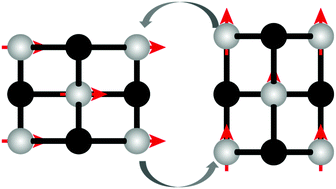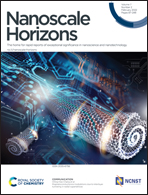A multiferroic vanadium phosphide monolayer with ferromagnetic half-metallicity and topological Dirac states†
Abstract
Ferroelasticity, ferromagnetism, half-metallicity, and topological Dirac states are properties highly sought in two-dimensional (2D) materials for advanced device applications. Here, we report first-principles prediction of a dynamically and thermally stable tetragonal vanadium phosphide (t-VP) monolayer that hosts all these desirable properties. This monolayer is substantially ferromagnetic with polarized spins aligned in the in-plane direction via a d–p–d super-exchange coupling mechanism; meanwhile, its tetragonal lattice enables an intrinsic in-plane ferroelasticity with a reversible strain of 23.4%. As a result, the ferroelasticity is strongly coupled with ferromagnetism via spin–orbit coupling to enable deterministic control over the magnetocrystalline anisotropy by an applied elastic strain. More interestingly, this multiferroic t-VP monolayer possesses half-metallicity with an anisotropic, topological Dirac cone residing in the majority-spin channel. We also predict a multiferroic t-CrN monolayer, whose ferromagnetism features a high Curie temperature of up to 478 K but is weakly coupled to its in-plane ferroelasticity. These results suggest a tetragonal 2D lattice as a robust atomic-scale scaffold on the basis of which fascinating electronic and magnetic properties can be rationally created by a suitable combination of chemical elements.



 Please wait while we load your content...
Please wait while we load your content...